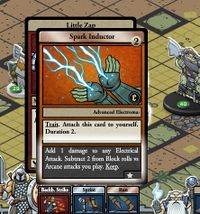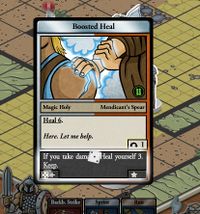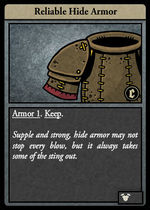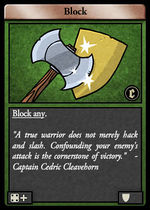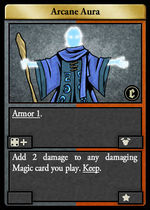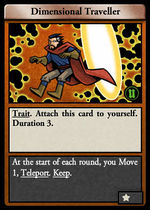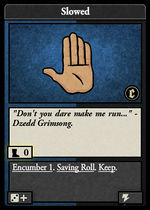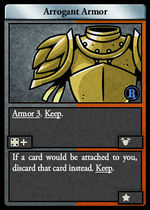Reactions and Traits
| Line 5: | Line 5: | ||
==Reactions== | ==Reactions== | ||
<p align="justify"> | <p align="justify"> | ||
| − | A reaction consists of a trigger condition, trigger effect and a trigger result. A trigger condition refers to the state required for the reaction to manifest/activate. Trigger effect refers to the function of the reaction while the trigger result refers to the outcome of the reaction. As reactions are tied to actions/state of the game itself, bounded action space translates into bounded reaction types. There are currently five broad types of reactions in game. | + | A reaction consists of a trigger condition, trigger effect and a trigger result. A trigger condition refers to the state required for the reaction to manifest/activate. Trigger effect refers to the function of the reaction while the trigger result refers to the outcome of the reaction. As reactions are tied to actions/state of the game itself, bounded action space translates into bounded reaction types. There are currently five broad types of reactions in game (Table 1). |
</p> | </p> | ||
{| class="chtable_b striped" style="margin-left: auto; margin-right: auto;" | {| class="chtable_b striped" style="margin-left: auto; margin-right: auto;" | ||
| − | |+ Types of Reactions | + | |+ Table 1: Types of Reactions |
|- | |- | ||
! Reaction !! Trigger condition !! Trigger effect !! Trigger result | ! Reaction !! Trigger condition !! Trigger effect !! Trigger result | ||
| Line 22: | Line 22: | ||
|- | |- | ||
| Special || Unique game state/action || Unique gameplay effect || Modified/unmodified effect passed | | Special || Unique game state/action || Unique gameplay effect || Modified/unmodified effect passed | ||
| + | |} | ||
| + | |||
| + | ===Card reactions=== | ||
| + | |||
| + | {| | ||
| + | | STYLE="vertical-align: center; text-align:justify;" align="left" | A reaction triggers whenever the trigger condition is satisfied. This happens immediately and the card bearing said reaction will always zoom to the center of screen. Figure 1 shows an actual gameplay where a dwarf wizard (hidden from view) plays [[Cards/Little Zap|little zap]] on an Ogre Bruiser. A card attachment [[Cards/Spark Inductor|Spark Inductor]], reacts to the attack played and modifies the block roll of [[Cards/Little Zap|little zap]]. [[Cards/Spark Inductor|Spark Inductor]] moves from the dwarf wizard to the center of the screen overlapping the [[Cards/Little Zap|little zap]] to indicate the reaction trigger. Thereafter, it moves back to the dwarf wizard. Figure 2 shows another example of a card reaction: [[Cards/Boosted Heal|Boosted Heal]] reacting to damage from the Ogre Bruiser. [[Cards/Boosted Heal|Boosted Heal]] moves to the center of the screen to indicate the reaction activated. A dice roll is made to determine if the heal reaction triggers. <br /><br /> Not all reactions trigger from attacks or from being attacked. Not all reactions require dice rolls. Not all reactions manifest as attachments, some like [[Cards/Boosted Heal|Boosted Heal]] react from hand. A card that reacts from hand becomes visible thereafter to all players. Below are some examples of common card reactions and the effect they bring. <br /><br /> <span style="color: yellow">'''IMPORTANT: All reactions are represented by a grey text background.'''</span> | ||
| + | | [[File:reaction_example1.jpg|thumb|200px|Fig. 1: Spark Inductor reacting to play of Little Zap]] | ||
| + | | [[File:reaction_example2.jpg|thumb|200px|Fig. 2: Boosted heal reacting to damage]] | ||
|} | |} | ||
| Line 27: | Line 35: | ||
{| | {| | ||
| − | | STYLE="vertical-align: center; text-align:justify;" align="left" rowspan=3| Figure 1 shows an example of a card with the {{K|Armor}} reaction: [[Cards/Reliable Hide Armor|Reliable Hide Armor]]. [[Cards/Reliable Hide Armor|Reliable Hide Armor]] is a common [[:Category:Armor_Card|armor]] card found in most low-level items. It reacts to incoming damage and reduces it by 1. As the die roll is 1+, [[Cards/Reliable Hide Armor|Reliable Hide Armor]] always mitigates incoming damage by 1 and is therefore an absolute damage reducer. Multiple [[Cards/Reliable Hide Armor|Reliable Hide Armors]] will stack the damage reduction as the reaction processes from the first to the next. Also note that any card bearing an {{K|Armor}} reaction has a grey background. <br /><br /> Figure 2 shows an example of a {{K|Block}} reaction: [[Cards/Block|Block]]. Unlike [[Cards/Reliable Hide Armor|Reliable Hide Armor]], the {{K|Block|Block}} trigger effect uses the keyword {{K|Block Any|Block any}}. This means that the trigger effect will negate any type of attack from the front provided the trigger condition is satisfied. In this case, the trigger condition is an incoming frontal attack with a die roll greater than 4 in order for the {{K|Block Any|Block any}} effect to occur. Successful trigger result 'blocks' the attack. Note that cards bearing the {{K|Block}} reaction have a green background. <br /><br /> Another common reaction is the Boost. There are many interpretations to the boost effect. In general, boosts are commonly used to increase or enhance an action/game state. [[Cards/Arcane Aura|Arcane Aura]] (Fig. 3) is a classic example of a boost reaction. It contains two reactions: an {{K|Armor}} reaction followed by a boost reaction. This means that [[Cards/Arcane Aura|Arcane Aura]] reacts on incoming damage as well as when the card bearer plays a damaging {{K|Magic}} card. The trigger condition is a play of a damaging Magic card. The trigger effect is to add 2 to the damage. If a card like [[Cards/Surging Bolt|Surging Bolt]] is played with [[Cards/Arcane Aura|Arcane Aura]] in hand, the total damage dealt to the target is raised from 3 to 5. Not all boost reactions increase damage, some like [[Cards/Dimensional Traveller|Dimensional Traveller]] boosts the game state via enhancements. In this case, the character with [[Cards/Dimensional Traveller|Dimensional Traveller]] gains an additional {{K|Teleport|teleport move}} of 1 tile at the start of each round. This is a highly useful positional ability. In addition, [[Cards/Dimensional Traveller|Dimensional Traveller]] also contains the {{K|Trait}} keyword which acts as an automatic card draw (covered in the Traits section below). All boost reactions are denoted by orange card backgrounds. <br /><br /> Handicap reactions are the polar opposite of boosts. Where boosts add and enhance gameplay, handicaps create detrimental effects. [[Cards/Slowed|Slowed]] is an example of a handicap reaction. It triggers when a positional change of the card bearer is detected. When the die roll is less than 4, the trigger effect ({{K|Encumber}}) is applied. [[Cards/Slowed|Slowed]] therefore reduces the movement range of the character by 1. With the {{K|Keep}} keyword, [[Cards/Slowed|Slowed]] is not discarded after it reacts. Instead, it will trigger if another move is detected, creating an annoying movement handicap chain. Handicap reactions does nothing beneficial to the player and are best avoided. However, a game feature of [http://www.cardhunter.com/ Card Hunter] consists of in-game quests requiring players to form parties using items with [[:Category:Handicap_Card|handicap]] cards. As such, learning to play with and around [[:Category:Handicap_Card|handicaps]] are an excellent way to differentiate between good players and great players. Again, note that Handicap reactions are denoted by black card backgrounds. <br /><br /> The last reaction cover the scope of special reactions that fall outside all above classifications. As of writing, the special reaction mechanic exists only on one card: [[Cards/Arrogant Armor|Arrogant Armor]]. [[Cards/Arrogant Armor|Arrogant Armor]] contains two reactions, an {{K|Armor}} trigger and a special reaction. The special reaction states "If a card would be attached to you, discard that card instead. {{K|Keep}}." A card is attached to a character when the card effect states "Attach to target/yourself". An example is that of [[Cards/Dimensional Traveller|Dimensional Traveller]] as shown previously. [[Cards/Arrogant Armor|Arrogant Armor's]] special reaction is designed to specifically negate attachments of any sort, beneficial or harmful. The trigger condition is an incoming card attachment to character while the trigger effect is to invoke immediate discard of said attachment. In short, [[Cards/Arrogant Armor|Arrogant Armor]] does not allow the character to be buffed or debuffed, acting as a natural deterrent and completely blocks a plethora of {{K|Stun|stun}}, {{K|Trait|traits}}, damage over time cards. This favors party builds revolving around the use of instants and immediate effects. Unlike the above reaction, special reactions do not have a dedicated card color. <br /><br /> In summary, reactions play a huge role in [http://www.cardhunter.com/ Card Hunter]. Dedicated players spend time carefully studying and experimenting with card reactions and deck synergy, making the right build for each character. The next section discusses an equally important game mechanic of {{K|Trait|traits}}. | + | | STYLE="vertical-align: center; text-align:justify;" align="left" rowspan=3| Figure 1 shows an example of a card with the {{K|Armor}} reaction: [[Cards/Reliable Hide Armor|Reliable Hide Armor]]. [[Cards/Reliable Hide Armor|Reliable Hide Armor]] is a common [[:Category:Armor_Card|armor]] card found in most low-level items. It reacts to incoming damage and reduces it by 1. As the die roll is 1+, [[Cards/Reliable Hide Armor|Reliable Hide Armor]] always mitigates incoming damage by 1 and is therefore an absolute damage reducer. Multiple [[Cards/Reliable Hide Armor|Reliable Hide Armors]] will stack the damage reduction as the reaction processes from the first to the next. Also note that any card bearing an {{K|Armor}} reaction has a grey background. <br /><br /> Figure 2 shows an example of a {{K|Block}} reaction: [[Cards/Block|Block]]. Unlike [[Cards/Reliable Hide Armor|Reliable Hide Armor]], the {{K|Block|Block}} trigger effect uses the keyword {{K|Block Any|Block any}}. This means that the trigger effect will negate any type of attack from the front provided the trigger condition is satisfied. In this case, the trigger condition is an incoming frontal attack with a die roll greater than 4 in order for the {{K|Block Any|Block any}} effect to occur. Successful trigger result 'blocks' the attack. Note that cards bearing the {{K|Block}} reaction have a green background. <br /><br /> Another common reaction is the Boost. There are many interpretations to the boost effect. In general, boosts are commonly used to increase or enhance an action/game state. [[Cards/Arcane Aura|Arcane Aura]] (Fig. 3) is a classic example of a boost reaction. It contains two reactions: an {{K|Armor}} reaction followed by a boost reaction. This means that [[Cards/Arcane Aura|Arcane Aura]] reacts on incoming damage as well as when the card bearer plays a damaging {{K|Magic}} card. The trigger condition is a play of a damaging Magic card. The trigger effect is to add 2 to the damage. If a card like [[Cards/Surging Bolt|Surging Bolt]] is played with [[Cards/Arcane Aura|Arcane Aura]] in hand, the total damage dealt to the target is raised from 3 to 5. Not all boost reactions increase damage, some like [[Cards/Dimensional Traveller|Dimensional Traveller]] boosts the game state via enhancements. In this case, the character with [[Cards/Dimensional Traveller|Dimensional Traveller]] gains an additional {{K|Teleport|teleport move}} of 1 tile at the start of each round. This is a highly useful positional ability. In addition, [[Cards/Dimensional Traveller|Dimensional Traveller]] also contains the {{K|Trait}} keyword which acts as an automatic card draw (covered in the Traits section below). All boost reactions are denoted by orange card backgrounds. <br /><br /> Handicap reactions are the polar opposite of boosts. Where boosts add and enhance gameplay, handicaps create detrimental effects. [[Cards/Slowed|Slowed]] is an example of a handicap reaction. It triggers when a positional change of the card bearer is detected. When the die roll is less than 4, the trigger effect ({{K|Encumber}}) is applied. [[Cards/Slowed|Slowed]] therefore reduces the movement range of the character by 1. With the {{K|Keep}} keyword, [[Cards/Slowed|Slowed]] is not discarded after it reacts. Instead, it will trigger if another move is detected, creating an annoying movement handicap chain. Handicap reactions does nothing beneficial to the player and are best avoided. However, a game feature of [http://www.cardhunter.com/ Card Hunter] consists of in-game quests requiring players to form parties using items with [[:Category:Handicap_Card|handicap]] cards. As such, learning to play with and around [[:Category:Handicap_Card|handicaps]] are an excellent way to differentiate between good players and great players. Again, note that Handicap reactions are denoted by black card backgrounds. <br /><br /> The last reaction cover the scope of special reactions that fall outside all above classifications. As of writing, the special reaction mechanic exists only on one card: [[Cards/Arrogant Armor|Arrogant Armor]]. [[Cards/Arrogant Armor|Arrogant Armor]] contains two reactions, an {{K|Armor}} trigger and a special reaction. The special reaction states "If a card would be attached to you, discard that card instead. {{K|Keep}}." A card is attached to a character when the card effect states "Attach to target/yourself". An example is that of [[Cards/Dimensional Traveller|Dimensional Traveller]] as shown previously. [[Cards/Arrogant Armor|Arrogant Armor's]] special reaction is designed to specifically negate attachments of any sort, beneficial or harmful. The trigger condition is an incoming card attachment to character while the trigger effect is to invoke immediate discard of said attachment. In short, [[Cards/Arrogant Armor|Arrogant Armor]] does not allow the character to be buffed or debuffed, acting as a natural deterrent and completely blocks a plethora of {{K|Stun|stun}}, {{K|Trait|traits}}, damage over time cards. This favors party builds revolving around the use of instants and immediate effects. Unlike the above reaction, special reactions do not have a dedicated card color. <br /><br /> In summary, reactions play a huge role in [http://www.cardhunter.com/ Card Hunter]. Dedicated players spend time carefully studying and experimenting with card reactions and deck synergy, making the right build for each character. Understanding what reactions are and how reactions work The next section discusses an equally important game mechanic of {{K|Trait|traits}}. |
| [[File:Reliable Hide Armor.jpeg|thumb|150px|Fig. 1: An armor reaction card]] | | [[File:Reliable Hide Armor.jpeg|thumb|150px|Fig. 1: An armor reaction card]] | ||
| [[File:Block.jpeg|thumb|150px|Fig. 2: A block reaction card]] | | [[File:Block.jpeg|thumb|150px|Fig. 2: A block reaction card]] | ||
Revision as of 23:32, 1 September 2013
One of the most unique feature set of Card Hunter lies in its reaction mechanics. In fact, it is so unique that the developer diaries contain three chapters (Jon talks about reactions, Skaff Elias talks about reactions, developers talk about more reactions) worth of explanations on the history, motivation and implementation. Readers are advised to browse the links for in-depth information and key insights. Another distinct gameplay feature revolves around the Trait mechanic. While card reactions provide a subtle way of streamlining gameplay flow, traits present more strategic deck building depth to the player. This guide presents some basics with regard to reactions and traits with examples of commonly encountered cards. Readers are advised to browse the Keywords guides for detailed information.
Contents |
Reactions
A reaction consists of a trigger condition, trigger effect and a trigger result. A trigger condition refers to the state required for the reaction to manifest/activate. Trigger effect refers to the function of the reaction while the trigger result refers to the outcome of the reaction. As reactions are tied to actions/state of the game itself, bounded action space translates into bounded reaction types. There are currently five broad types of reactions in game (Table 1).
| Reaction | Trigger condition | Trigger effect | Trigger result |
|---|---|---|---|
| Armor | Incoming damage + die roll (optional) | Damage type damage reduction | Modified/unmodified damage value passed |
| Block | Incoming attack from front + die roll (optional) | Attack type negation | Modified/unmodified attack passed |
| Boost | Change in game state/action + die roll (optional) | Add/enhance game state/action | Apply additions/enhancement |
| Handicap | Change in game state/action + die roll (optional) | Add negative state/action | Apply negative state |
| Special | Unique game state/action | Unique gameplay effect | Modified/unmodified effect passed |
Card reactions
| A reaction triggers whenever the trigger condition is satisfied. This happens immediately and the card bearing said reaction will always zoom to the center of screen. Figure 1 shows an actual gameplay where a dwarf wizard (hidden from view) plays little zap on an Ogre Bruiser. A card attachment Spark Inductor, reacts to the attack played and modifies the block roll of little zap. Spark Inductor moves from the dwarf wizard to the center of the screen overlapping the little zap to indicate the reaction trigger. Thereafter, it moves back to the dwarf wizard. Figure 2 shows another example of a card reaction: Boosted Heal reacting to damage from the Ogre Bruiser. Boosted Heal moves to the center of the screen to indicate the reaction activated. A dice roll is made to determine if the heal reaction triggers. Not all reactions trigger from attacks or from being attacked. Not all reactions require dice rolls. Not all reactions manifest as attachments, some like Boosted Heal react from hand. A card that reacts from hand becomes visible thereafter to all players. Below are some examples of common card reactions and the effect they bring. IMPORTANT: All reactions are represented by a grey text background. |
Examples of card bearing reactions
| Figure 1 shows an example of a card with the Armor reaction: Reliable Hide Armor. Reliable Hide Armor is a common armor card found in most low-level items. It reacts to incoming damage and reduces it by 1. As the die roll is 1+, Reliable Hide Armor always mitigates incoming damage by 1 and is therefore an absolute damage reducer. Multiple Reliable Hide Armors will stack the damage reduction as the reaction processes from the first to the next. Also note that any card bearing an Armor reaction has a grey background. Figure 2 shows an example of a Block reaction: Block. Unlike Reliable Hide Armor, the Block trigger effect uses the keyword Block any. This means that the trigger effect will negate any type of attack from the front provided the trigger condition is satisfied. In this case, the trigger condition is an incoming frontal attack with a die roll greater than 4 in order for the Block any effect to occur. Successful trigger result 'blocks' the attack. Note that cards bearing the Block reaction have a green background. Another common reaction is the Boost. There are many interpretations to the boost effect. In general, boosts are commonly used to increase or enhance an action/game state. Arcane Aura (Fig. 3) is a classic example of a boost reaction. It contains two reactions: an Armor reaction followed by a boost reaction. This means that Arcane Aura reacts on incoming damage as well as when the card bearer plays a damaging Magic card. The trigger condition is a play of a damaging Magic card. The trigger effect is to add 2 to the damage. If a card like Surging Bolt is played with Arcane Aura in hand, the total damage dealt to the target is raised from 3 to 5. Not all boost reactions increase damage, some like Dimensional Traveller boosts the game state via enhancements. In this case, the character with Dimensional Traveller gains an additional teleport move of 1 tile at the start of each round. This is a highly useful positional ability. In addition, Dimensional Traveller also contains the Trait keyword which acts as an automatic card draw (covered in the Traits section below). All boost reactions are denoted by orange card backgrounds. Handicap reactions are the polar opposite of boosts. Where boosts add and enhance gameplay, handicaps create detrimental effects. Slowed is an example of a handicap reaction. It triggers when a positional change of the card bearer is detected. When the die roll is less than 4, the trigger effect (Encumber) is applied. Slowed therefore reduces the movement range of the character by 1. With the Keep keyword, Slowed is not discarded after it reacts. Instead, it will trigger if another move is detected, creating an annoying movement handicap chain. Handicap reactions does nothing beneficial to the player and are best avoided. However, a game feature of Card Hunter consists of in-game quests requiring players to form parties using items with handicap cards. As such, learning to play with and around handicaps are an excellent way to differentiate between good players and great players. Again, note that Handicap reactions are denoted by black card backgrounds. The last reaction cover the scope of special reactions that fall outside all above classifications. As of writing, the special reaction mechanic exists only on one card: Arrogant Armor. Arrogant Armor contains two reactions, an Armor trigger and a special reaction. The special reaction states "If a card would be attached to you, discard that card instead. Keep." A card is attached to a character when the card effect states "Attach to target/yourself". An example is that of Dimensional Traveller as shown previously. Arrogant Armor's special reaction is designed to specifically negate attachments of any sort, beneficial or harmful. The trigger condition is an incoming card attachment to character while the trigger effect is to invoke immediate discard of said attachment. In short, Arrogant Armor does not allow the character to be buffed or debuffed, acting as a natural deterrent and completely blocks a plethora of stun, traits, damage over time cards. This favors party builds revolving around the use of instants and immediate effects. Unlike the above reaction, special reactions do not have a dedicated card color. In summary, reactions play a huge role in Card Hunter. Dedicated players spend time carefully studying and experimenting with card reactions and deck synergy, making the right build for each character. Understanding what reactions are and how reactions work The next section discusses an equally important game mechanic of traits. |
||
Traits
Unlike reactions, traits are not as complicated and follow simple rules. However, it has important and strategic significance in deck building and game play. A card bearing the Trait keyword forces the player to play it when drawn. It takes precedence over all other in-hand cards and play is stopped until all trait cards are played. A player may select the order in which to play trait cards when multiples occur. A player cannot pass while holding a Trait card. The real kicker of traits are:
- Playing a Trait card does not end the player's turn.
- When a Trait card is played, draw another card.
